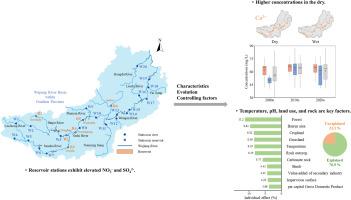含水库喀斯特河水化学特征、演化及控制因素:来自时空分析的启示
IF 6.3
2区 环境科学与生态学
Q1 ENVIRONMENTAL SCIENCES
引用次数: 0
摘要
了解喀斯特地区的水化学对于改善全球水资源管理和加深我们对形成这些敏感环境的生物地球化学循环的认识至关重要。尽管在喀斯特水文学方面取得了进展,但在长期趋势、潜在过程和环境变化的定量影响方面仍存在重大差距。这在中国的吴江等地区尤其如此,在那里,水库建设和土地利用/覆盖变化等人类活动加速了水化学变化。结合近期和历史监测数据,详细分析了WJ中主要离子的时空特征、演变及其控制因素。这些发现对当地水资源管理具有重要意义,并有助于全球努力管理面临人为压力的类似喀斯特系统。我们的研究表明,溶质浓度存在明显的季节差异,旱季的浓度更高。WJ的水富含钙,Ca-HCO3离子对是最常见的。水库监测站的NO3−和SO42−水平比河流监测站高得多,这可能是由于水力滞留时间较长和酸沉积增加所致。研究证实了pH值和水温在岩石风化过程中的重要作用。土地利用/覆被变化是溶质变化的主要驱动因素(46.37%),其次是岩性(13.92%)和温度(8.35%)。在过去的二十年里,已经观察到强烈的碳酸盐风化作用,特别是在雨季。在岩溶省份中,贵州省离子浓度最高,表明其岩溶覆盖范围广,风化作用加剧。本文章由计算机程序翻译,如有差异,请以英文原文为准。

Hydrochemical characteristics, evolution, and controlling factors of a karstic river with reservoirs: Insights from spatial-temporal analysis
Understanding water chemistry in karst regions is crucial for improving global water resource management and deepening our knowledge of the biogeochemical cycles shaping these sensitive environments. Despite advancements in karst hydrology, significant gaps remain in long-term trends, underlying processes, and quantitative effects of environmental changes. This is especially true in areas like the Wujiang River (WJ) in China, where human activities such as reservoir construction and land use/cover changes have accelerated hydrochemical changes. We combined recent and historical monitoring data to provide a detailed analysis of the spatial and temporal characteristics, evolution, and controlling factors of major ions in WJ. These findings are important for local water management and contribute to global efforts to manage similar karst systems facing human-induced pressures. Our research shows clear seasonal differences in solute concentrations, with higher levels during the dry season. WJ's water is rich in calcium, with Ca-HCO3 ion pairs being the most common. Reservoir monitoring stations show much higher levels of NO3− and SO42− compared to river-type stations, likely due to longer hydraulic retention time and increased acid deposition. The study confirms the significant role of pH and water temperature in rock weathering processes. Land use/cover changes were identified as the primary drivers of solute variations (46.37 %), followed by lithology (13.92 %) and temperature (8.35 %). Over the past two decades, intense carbonate weathering has been observed, especially during wet seasons. Among karstic provinces, Guizhou Province stands out with the highest ion concentrations, indicative of its extensive karst coverage and heightened weathering processes.
求助全文
通过发布文献求助,成功后即可免费获取论文全文。
去求助
来源期刊

Journal of Environmental Sciences-china
环境科学-环境科学
CiteScore
13.70
自引率
0.00%
发文量
6354
审稿时长
2.6 months
期刊介绍:
The Journal of Environmental Sciences is an international journal started in 1989. The journal is devoted to publish original, peer-reviewed research papers on main aspects of environmental sciences, such as environmental chemistry, environmental biology, ecology, geosciences and environmental physics. Appropriate subjects include basic and applied research on atmospheric, terrestrial and aquatic environments, pollution control and abatement technology, conservation of natural resources, environmental health and toxicology. Announcements of international environmental science meetings and other recent information are also included.
 求助内容:
求助内容: 应助结果提醒方式:
应助结果提醒方式:


